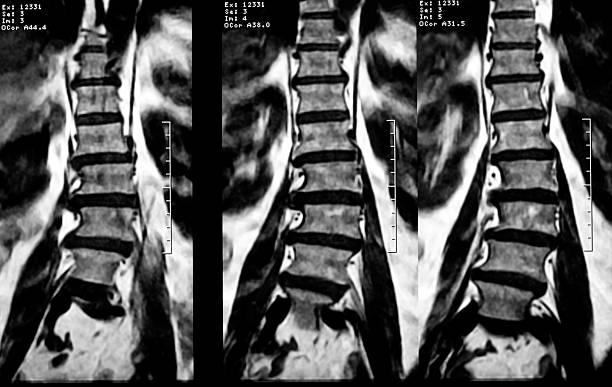- “Scoliosis” -Greek word meaning “crooked”.
- It is a lateral curvature of the spine in upright position.
- The Scoliosis Research Society has defined scoliosis as a lateral curvature of the spine greater than 10 degree as measured using the Cobbs method on a standing radiograph.
- Triplanar deformity of lordosis, rotation & lateral wedging of vertebrae.
- It produces body disfigurement. When deformity is extreme it compresses viscera & reduces life expectancy of the patient.
Incidence of scoliosis:
- Develops between ages 8-15.
- 7 times more prevalent in females.
- 80%of scoliosis orign unknown.
Spinal Biomechanics:
- “Normal” alignment
Spinous processes all lined up in a straight line up in a straight over the sacrum.
- Scoliosis is a combination of
Angular displacement
Lateral displacement.

Normal Alignment


Lateral Displacement
Classification:
- Non Structural Scoliosis(Postural)
- Transient Structural Scoliosis
- Structural Scoliosis
Non Structural Scoliosis:
- Postural Scoliosis
- Compensatory Scoliosis
Transient Structural Scoliosis:
- Sciatic Scoliosis
- Hysterical Scoliosis
- Inflamatory Scoliosis
Structural Scoliosis:
- Idiopathic Scoliosis
- Old Classification
- Infantile Onset<3yrs Age
- Juvenile Onset3-10yrs Age
- Adolescent Onset >10yrs Age
New Classification
- Early Onset Onset< 8yrs
- Late Onset Onset>8yrs
Congenital Scoliosis
It has 2 types
Extra Vertebral
- Congenital rib fusion
Vertebral
It has further 2 types
1. Open-with posterior spine defect
- Meningeomyelocele
- Spina bifid occulta
2. Closed intact posterior elements
- Diastematomyelia
- Hemivertebras
TRAUMATIC SCOLIOSIS
- Vertebral
eg: Fractures, irradiation Surgery
- Extra vertebral
eg: Burns
OTHER CAUSES OF SCOLIOSIS
- Neurofibramatosis
- Marfan’s syndrome
- Moroquio’s disease
- Arthrogryposis multiplex congenita
- Rheumatoid arthritis
- Stills disease
- Scheuermann’s disease
- Osteogenesis imperfecta
- Scoliosis assosiated with spinal tumours.
Physiological Effects of Scoliosis
- Mid-back pain
- Lower back pain,
- Neck pain, headaches,
- Premature disc and joint degeneration
- Decreased pulmonary function
INFANTILE IDIOPATHIC SCOLIOSIS
- Younger than age of 3 years
- Boys > girls,
- Primarily thoracic and convex to the left.
- One hip is prominent but no ribs to accentuate deformity
- Associated with Mental deficiency,
- Congenital dislocation of hip,
- Congenital heart defects
→ Self-limiting
- Spontaneously resolve (70% to 90%)
- Progressive –
Compensatory or secondary curves develop,
– > 37 degrees by Cobb Method
ADOLESCENT IDIOPATHIC SCOLIOSIS
- Commonest type
- Age 10- 16 yrs
- Primary thoracic curve usually convex to right
- Lumbar curves to the left
- Intermediate (thoracolumbar) & combined (double primary) curves also occur
- Curves under 20 degree either spontaneously or remain unchanged
Proposed etiological factors,
(1) genetic factors,
(2) neurological disorders,
(3) hormonal and metabolic dysfunction,
(4) skeletal growth,
(5) biomechanical factors, and
(6) environmental and lifestyle factors
Once starts to progress, it goes on throughout growth period
Reliable predictors of progression
1) Very young age
2) Marked curvature
3) Incomplete Risser sign at presentation
CLINICAL FEATURES
- Deformity is usually the presenting symptom
- Pain is rare complaint
- Rib hump or abnormal para spinal muscular prominence indicates spinal rotation.
- Rib hump leads to asymmetry of trunk called angle trunk rotation (ATR) .
CLINICAL EVALUATION
- Trunk should be exposed completely & examined in front, back & side
Trunk alignment
→ Symmetry of shoulder girdles
➡ Scapula & ribcage observed for asymmetry
- Spinous process palpated to determine their alignment
- Plumb line – On posterior aspect, line drawn from occiput should normally align with
gluteal cleft.
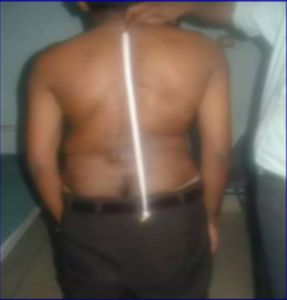
SCOLIOMETRY
- The patient bends over, arms dangling and palms pressed together, until a curve is observed in the back.
- The Scoliometer is placed on the back and measures the apex (the highest point) of the upper back curve.
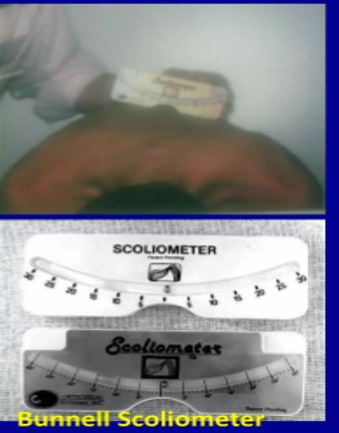
Adam Forward Bending Test
Patient is asked to lean forward with feet together and bend 90 degrees at the waist.
The examiner can easily view the angle & any asymmetry of the trunk or any abnormal spinal curvatures.

Conservative Treatment:
Braces: When children’s bones are still growing and he or she has moderate scoliosis, the doctor may recommend a brace. Wearing a brace won’t cure scoliosis or reverse the curve, but it usually prevents further progression of the curve. The most common type of brace is made of plastic and is contoured to conform to the body. This brace is almost invisible under the clothes, as it fits under the arms and around the rib cage, lower back and hips. eg Milwaukee brace
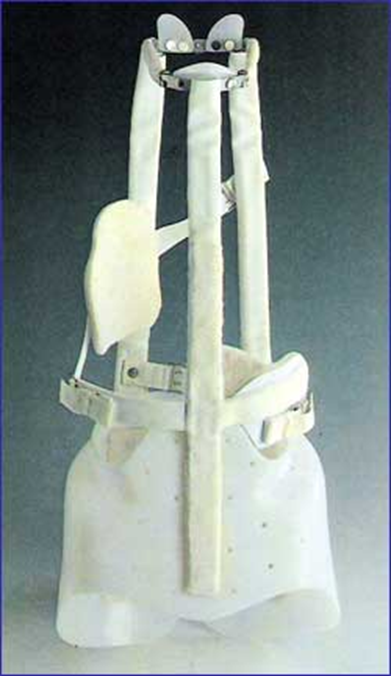
Physical Therapy Management
Physical therapy and bracing are used to treat milder forms of scoliosis to maintain cosmesis and avoid surgery. Scoliosis is not just a lateral curvature of the spine, it’s a three dimensional condition. To manage scoliosis work in three planes: the sagittal, frontal and transverse.
Conservative therapy consists of:
- physical exercises
- bracing
- manipulation
- electrical stimulation
Aims
The aims of physical therapy are:
- Autocorrection 3D
- Coordination
- Equilibrium
- Ergonomical corrections
- Muscular endurance/ strength
- Neuromotor control of the spine
- Increase of ROM
- Respiratory capacity/ education
- Side-shift
- Stabilization
Schroth method
The goal of Schroth exercises is to de-rotate, elongate and stabilize the spine in a three-dimensional plane. This is achieved through physical therapy that focuses on:
- Restoring muscular symmetry and alignment of posture
- Breathing into the concave side of the body
- Teaching you to be aware of your posture
- The purpose of these exercises is to derotate, deflex and to correct the spine in the sagittal plane while elongating the spine.
Door handle exercise
Patient with right thoracic scoliosis (functional 3-curve pattern as seen on the left) performing the ‘Door handle exercise’ according to the new ‘Power Schroth’ principles. The corrected head alignment is not yet achieved but correction of the sagittal profile is already visible.

Frog at the pond
Patient with right thoracic scoliosis (functional 3-curve pattern as seen on the left) performing the exercise ‘Frog at the pond’ according to the new ‘Power Schroth’ principles (right). The corrected head alignment is not yet achieved but correction of the sagittal profile is already visible.
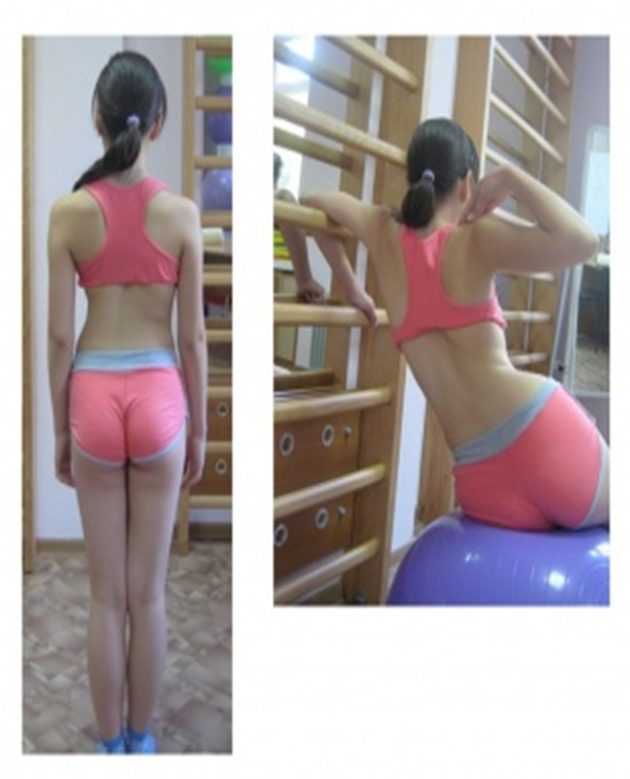
The patient needs to be focused about re-establishing spinal symmetry. The key to a successful therapy is to work consistently to correct the spine. A difficult part of the therapy is to learn to shorten the muscles on the convex side of the spine and lengthen the muscles on the concave side of the side (muscles become imbalanced on opposite sides. The exercise position approaches the functional/structural threshold. Schroth therapy takes advantage of the overcorrected positions. Basic corrections are reviewed by using mirrors in front and at the back of the patient. This posture requires concentration and coordination, applying the correct breathing, and well-adapted muscle length and tension.
Klapp exercises
These are another exercise program. It was a nonsurgical method established with the aim of correcting the spinal curvature by stretching and strengthening the back muscles.

Breathing exercises
Breathing exercises combined with the thoracic active mobilisations are another important aspect of physiotherapy. The severity of the curvature can cause a pressure on airways and lungs. The patient can experience trouble while breathing. If the risk of pulmonary dysfunction (as a result of the pressure of the spine) is too high, surgery is indicated.
Pilates
This intervention was divided into three parts:
- Preparation (warm up + stretch)
- Warm-up consisted of eight minutes walking on a treadmill or an elliptical machine. After the warm-up each patient had to do some stretching exercises:
- Spine Forward stretching
- Upper rolling
- Child Position
- Forward leg pull
Specific exercises
- For these exercise Swiss balls, Flex Ball Quarks are used. It’s important that the patients learn to breathe right during exercise.
- Hip movements with a large ball. Goal: Strengthening the gluteal muscles and developing the equilibrium.
- Inverted abdominal skills with a ball. Goal: Strengthening the infraabdominal region and the ischiotibial muscles.
- Rising into a seated position. Goal: Strengthening the M. rectus abdominis.
- Lateral spine movement. Goal: Stretching the lateral muscle chain according to the direction of convexity of the scoliosis.
About Authors
Dr. Muhammad Mahmood Ahmad is a Spinal as well as an Orthopedic Surgeon with over 14 years of experience currently practicing at Razia Saeed Hospital, Multan.

